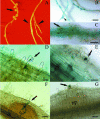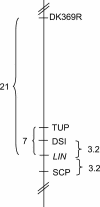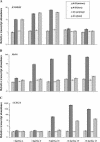LIN, a Medicago truncatula gene required for nodule differentiation and persistence of rhizobial infections
- PMID: 15516512
- PMCID: PMC527166
- DOI: 10.1104/pp.104.045575
LIN, a Medicago truncatula gene required for nodule differentiation and persistence of rhizobial infections
Abstract
Ethyl methanesulfonate mutagenesis of the model legume Medicago truncatula has previously identified several genes required for early steps in nodulation. Here, we describe a new mutant that is defective in intermediate steps of nodule differentiation. The lin (lumpy infections) mutant is characterized by a 4-fold reduction in the number of infections, all of which arrest in the root epidermis, and by nodule primordia that initiate normally but fail to mature. Genetic analyses indicate that the symbiotic phenotype is conferred by a single gene that maps to the lower arm of linkage group 1. Transcriptional markers for early Nod factor responses (RIP1 and ENOD40) are induced in lin, as is another early nodulin, ENOD20, a gene expressed during the differentiation of nodule primordia. By contrast, other markers correlated with primordium differentiation (CCS52A), infection progression (MtN6), or nodule morphogenesis (ENOD2 and ENOD8) show reduced or no induction in homozygous lin individuals. Taken together, these results suggest that LIN functions in maintenance of rhizobial infections and differentiation of nodules from nodule primordia.
Figures





Similar articles
-
Rhizobial infection is associated with the development of peripheral vasculature in nodules of Medicago truncatula.Plant Physiol. 2013 May;162(1):107-15. doi: 10.1104/pp.113.215111. Epub 2013 Mar 27. Plant Physiol. 2013. PMID: 23535942 Free PMC article.
-
nip, a symbiotic Medicago truncatula mutant that forms root nodules with aberrant infection threads and plant defense-like response.Plant Physiol. 2004 Nov;136(3):3692-702. doi: 10.1104/pp.104.049064. Epub 2004 Oct 29. Plant Physiol. 2004. PMID: 15516506 Free PMC article.
-
The non-specific lipid transfer protein N5 of Medicago truncatula is implicated in epidermal stages of rhizobium-host interaction.BMC Plant Biol. 2012 Dec 7;12:233. doi: 10.1186/1471-2229-12-233. BMC Plant Biol. 2012. PMID: 23217154 Free PMC article.
-
Sinorhizobium meliloti succinylated high-molecular-weight succinoglycan and the Medicago truncatula LysM receptor-like kinase MtLYK10 participate independently in symbiotic infection.Plant J. 2020 Apr;102(2):311-326. doi: 10.1111/tpj.14625. Epub 2020 Jan 11. Plant J. 2020. PMID: 31782853 Free PMC article.
-
Transcription of ENOD8 in Medicago truncatula nodules directs ENOD8 esterase to developing and mature symbiosomes.Mol Plant Microbe Interact. 2008 Apr;21(4):404-10. doi: 10.1094/MPMI-21-4-0404. Mol Plant Microbe Interact. 2008. PMID: 18321186
Cited by
-
A Medicago truncatula Cystathionine-β-Synthase-like Domain-Containing Protein Is Required for Rhizobial Infection and Symbiotic Nitrogen Fixation.Plant Physiol. 2016 Apr;170(4):2204-17. doi: 10.1104/pp.15.01853. Epub 2016 Feb 16. Plant Physiol. 2016. PMID: 26884486 Free PMC article.
-
How many E3 ubiquitin ligase are involved in the regulation of nodulation?Plant Signal Behav. 2011 May;6(5):660-4. doi: 10.4161/psb.6.5.15024. Epub 2011 May 1. Plant Signal Behav. 2011. PMID: 21543887 Free PMC article. Review.
-
The lss supernodulation mutant of Medicago truncatula reduces expression of the SUNN gene.Plant Physiol. 2010 Nov;154(3):1390-402. doi: 10.1104/pp.110.164889. Epub 2010 Sep 22. Plant Physiol. 2010. PMID: 20861425 Free PMC article.
-
NPR1 protein regulates pathogenic and symbiotic interactions between Rhizobium and legumes and non-legumes.PLoS One. 2009 Dec 21;4(12):e8399. doi: 10.1371/journal.pone.0008399. PLoS One. 2009. PMID: 20027302 Free PMC article.
-
The Medicago truncatula SUNN gene encodes a CLV1-like leucine-rich repeat receptor kinase that regulates nodule number and root length.Plant Mol Biol. 2005 Aug;58(6):809-822. doi: 10.1007/s11103-005-8102-y. Plant Mol Biol. 2005. PMID: 16240175
References
-
- Ané JM, Kiss GB, Riely BK, Penmetsa RV, Oldroyd GE, Ayax C, Lévy J, Debellé F, Baek JM, Kalo P, et al (2004) Medicago truncatula DMI1 required for bacterial and fungal symbioses in legumes. Science 303: 1364–1367 - PubMed
-
- Ben Amor B, Shaw SL, Oldroyd GED, Maillet F, Penmetsa RV, Cook D, Long SR, Dénarié J, Gough C (2003) The NFP locus of Medicago truncatula controls an early step of Nod factor signal transduction upstream of a rapid calcium flux and root hair deformation. Plant J 34: 1–12 - PubMed
-
- Caetano-Anollés G, Paparozzi ET, Gresshoff PM (1991) Mature nodules and root tips control nodulation in soybean. J Plant Physiol 137: 389–396
Publication types
MeSH terms
Substances
Associated data
- Actions
- Actions
- Actions
LinkOut - more resources
Full Text Sources
Miscellaneous

